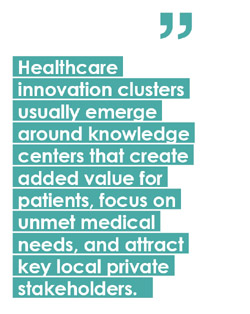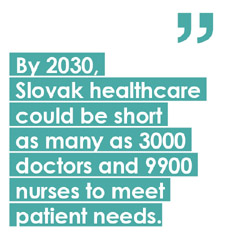Turning Challenges into Innovation Drivers
The urgency of challenges Slovakia faces as a country creates room for innovative technologies to improve the health outcomes of Slovak patients and increase the efficiency of diagnosis and treatment for healthcare providers. The real opportunity will be to create a favorable environment for developing, validating, and commercializing innovative healthcare products and services in the highly regulated healthcare market.
Examples of healthcare innovation clusters from other countries illustrate that these clusters usually emerge around knowledge centers that create added value for patients, focus on unmet medical needs, and attract key local private stakeholders.
To date, collaborations are not very systematic, yet major infrastructural investments planned in the next five years could accelerate clustering and attract major private biotechnology and IT companies’ attention. Other emerging healthcare innovation initiatives around Slovakia could benefit from a deeper engagement with the Žilina region, as it will have an advantage of pre-existing clustering and state of the art healthcare infrastructure.
Additional private and public sector initiatives should focus on unmet clinical needs and acceleration of innovation growth through networking and international expertise, rather than compete for a few excellent research facilities. Universities and the Ministry of Health should coordinate networking and knowledge exchange to further cluster innovators with a vision to transform and innovate the current healthcare system across Slovakia.

Local Healthcare Challenges Create Opportunities for Innovation
According to the European Commission, Heart disease and stroke account for 30-35% of all deaths in Slovakia, followed by lung and colorectal cancer. The current healthcare system is already strained due to inherent inefficiencies and administrative burdens. Moreover, The Slovak Medical Chamber indicates that the system may face a severe shortage of trained workers in ten years if significant educational reforms are not implemented. By 2030, Slovak healthcare could be short as many as 3000 doctors and 9900 nurses to meet patient needs.
An aging population will exacerbate the problem in the upcoming decade. The number of people aged 65+ is projected to increase from 16% to 21% by 2030 (Infostat). Such demographic changes will put much pressure on the healthcare system and increase overall expenditure since elderly patients require more frequent medical attention and have a higher incidence of more severe diagnoses, including cardiovascular diseases (CVDs) and cancer.
Patients with CVDs or cancer can live longer and better lives with more timely and accurate diagnosis or application of new technologies that enable more accurate and even remote patient management. Moreover, AI and machine learning software to augment medical decision- making during diagnosis or treatment is becoming common nowadays, even in Slovak hospitals. Such innovations could help offset an insufficient healthcare workforce since novel technologies allow healthcare workers to work more efficiently and provide healthcare at lower costs per patient.
Multiple global indicators and rankings emphasize the big potential of Slovak biomedical research, STEM graduates, and innovators to create innovative solutions to the outlined challenges. The question is how to create a nurturing environment for the complicated and highly regulated processes of healthcare innovation?
Strong Academic Institutions Focusing on Healthcare Innovation
The region’s two universities, the University of Žilina and Jessenius Faculty of Comenius University in Martin, have strong academic research traditions. The University of Žilina has extensive experience in applied research and impact on decision-making, mainly in transportation and mobility areas. Recently, multiple faculties have realized that this expertise and knowledge can be transferred to other sectors and have started to shift the focus towards biomedical research due to the greater impact of the field and funding opportunities.
For example, Žilina’s Faculty of Management Science & Informatics researchers have engaged in international collaborations in applied HealthTech research and participate in creating novel IT applications for unmet clinical needs during the Covid-19 pandemic. The Faculty has also recently launched a new Master’s program in Biomedical Informatics. The program’s goal is to train engineers in developing systems and applications for healthcare and equip them with knowledge in biomedicine, data analytics, and bioinformatics. Although the program has been accredited for just two years, it has attracted private stakeholders’ attention and has great potential to generate young innovators.
The Jessenius Faculty of Medicine in Martin is part of the Comenius University and is one of Slovakia’s three medical faculties. The Faculty has a long tradition of producing excellent clinical research and establishing international research collaborations. This year, the project to establish a national Biobank for oncology and rare disease by the Jessenius Faculty has been approved thanks to extensive collaboration with the Ministry of Health. Jessenius Faculty will be leading the project with important stakeholders as project partners, including the University of Žilina, or Slovak Academy of Sciences.
Further, the local healthcare community was able to secure funding to construct a new state-of-the-art university hospital, which will be built in the next five years. The hospital will be closely connected to the clinical research and teaching facilities on Jessenius Faculty. The project’s team aims to design the hospital to facilitate continuous piloting and integrating innovative processes and cutting-edge technologies. New infrastructure could provide pre-clinical validation and testing opportunities for emerging startups, spin-offs, or biomedical companies. Therefore, the region will be equipped with important infrastructure to form a strong innovation cluster.
Geographic Anchoring and Tradition of Cooperation
The academic institutions in Žilina and Martin have established close ties over the 60+ years of co-existence in the region. Although some faculties and departments in Žilina have only been established in the last decades, cross-institutional collaborations have been easily set-up. A few key players in the region fully utilize the geographical proximity and relatively small size of the ecosystem and ensure continuity of cooperation by facilitating networking and organizing conferences or workshops.
The most recent example is a conference that focused on AI applications in medicine and radiology organized with the Jessenius faculty. Furthermore, both universities’ research teams engage in joint research projects in biomedicine and small-scale IT applications for clinical practice.

The collaborations among the two institutions and external stakeholders lack a more high-level and long-term vision. Although the faculties have declared interest in their joint long-term efforts, systematic coordination or commitment on the level of directors has not been formalized. Nevertheless, the key players in academia have developed strong interpersonal relationships that could serve as a nucleation point for a larger group effort involving additional stakeholders from the region.
The University of Žilina has a strong history of working with the private sector in the region since the 1990s. The Faculty of Management Science & Informatics has formed 32 official partnerships with private companies alone. For example, Siemens Healthineers and Stapro Slovakia, innovative HealthTech companies, are engaged in the Biomedical Informatics program’s practical education. The partnerships are currently small scale and mostly focus on contract research or research projects for graduates and have not led to widespread innovation efforts. However, the Faculty is developing an online platform that would facilitate further collaboration between academia and the private sector on biomedical research.
Jessenius Faculty has also been active in building rapport with the private sector. The university hospital clinicians are already piloting an innovative radiology diagnostic system provided by an international biomedical company. The system utilizes AI to help radiologists make more accurate and timely decisions in difficult cases. Moreover, local clinicians are engaged in designing and piloting the innovative system and are becoming national key opinion leaders and ambassadors to integrate similar innovative technologies into clinical practice.
Seeking Synergies with the Region
Although the region has a strong track record in academia and produces excellent research, it lacks several elements that would make it a potent healthcare innovation cluster - greater long-term vision, the attraction of innovators and startups, and systematic facilitation of technology transfer. Most of these gaps could be filled through synergies with other emerging innovation hotspots driven by the private and public sectors.
An excellent example of a complementary hotspot is the HealthCare Lab accelerator supported by Roche Slovakia, a leading global biotechnology company. The local affiliate of Roche sees huge potential in local researchers and innovators’ capabilities. Accordingly, they launched a community-building initiative that would connect, grow, and nurture the community of innovators, researchers, healthcare providers, and regulators to bring ground-breaking innovations in healthcare to the market faster. The initiative attracts the most promising HealthTech startups in the CEE region and provides coaching, education, and mentoring for the founders over a four-month period to help them bring their innovations to the market faster.
The involvement of key private sector stakeholders could complement the emerging cluster by providing international expertise and network necessary for accelerated commercialization of emerging technologies and innovations in the region. On top of valuable know-how, private companies such as Roche Slovakia can generate the long-term vision, bring a perspective of future healthcare industry trends and focus on patients and clinical needs, which are often lacking in academic research healthcare innovation initiatives driven by the public sector.
Private stakeholders with complementary resources will be attracted to the Žilina region by know-how concentration, the potential for clinical validation, networking, and PR and marketing opportunities. However, private healthcare companies are often deterred from collaboration with academic institutions because of complicated bureaucracy and unclear contact points at academic institutions. Therefore, regional players should actively engage in building networks with external partners through conferences and awareness-building activities beyond the boundaries of academia.
****
This text was originally pub-lished in “Slovakia: Regional Innovation Ecosystems of the Future: A Vision Beyond 2020”, a report prepared by CIVITTA and EIT Digital. The report advances the Slovak innovation ecosystem’s vision and strategy by promoting the most promising sectors and areas of in-novation in the country. It maps and analyzes five emerging entrepreneur-ial and technology-driven sectors and communities. The full report can be accessed here: https://mailchi.mp/civitta/slovakia-regional-innovation-ecosystems-of-the-future
Martin Veselý, Senior Consultant, CIVITTA Slovakia



Follow us